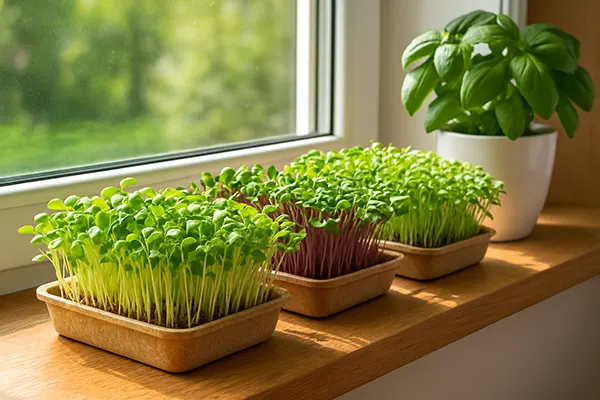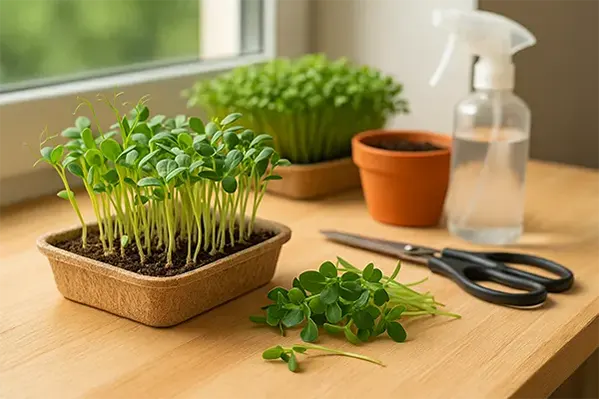
Home Microgreens: Growing Vitamins on Your Windowsill
In the fast pace of modern life, many people seek ways to maintain a healthy diet without spending much time or money. One of the most practical and sustainable options is growing microgreens at home. These tiny plants are full of nutrients, easy to cultivate, and can turn any windowsill into a mini-garden that provides fresh greens all year round.
What Are Microgreens and Why They Matter
Microgreens are young edible plants harvested shortly after sprouting, usually when they have developed their first pair of true leaves. They are richer in vitamins, minerals, and antioxidants than their mature counterparts. Common types include radish, sunflower, broccoli, basil, and mustard greens.
Unlike full-grown vegetables, microgreens can be cultivated indoors in just a few weeks. Their compact size allows you to grow them even in small flats without the need for complex equipment or large containers. All you need is light, warmth, and moisture to start your green adventure.
Because of their high concentration of nutrients, microgreens are often called “living vitamins”. Studies show they can contain up to 40 times more nutrients than mature plants, making them a perfect addition to salads, sandwiches, smoothies, or as a garnish for hot dishes.
How Microgreens Support a Healthy Lifestyle
Eating microgreens regularly boosts immunity, improves digestion, and supports cardiovascular health. For example, red cabbage and kale microgreens are rich in vitamin C, while sunflower shoots provide valuable plant-based proteins and healthy fats.
These greens also help balance blood sugar levels and fight inflammation, which is essential for preventing chronic illnesses. Adding a small portion of microgreens to your daily diet is an easy step towards better overall well-being.
Moreover, growing microgreens yourself brings psychological benefits. Watching plants grow from seeds to edible greens helps reduce stress and creates a sense of connection with nature — something that is often missing in urban environments.
How to Grow Microgreens at Home
To begin, choose suitable seeds. You can purchase them in garden stores or online, ensuring they are organic and untreated. Popular beginner choices are peas, radish, and broccoli. These varieties germinate quickly and have a pleasant, mild flavour.
Next, prepare shallow containers with drainage holes and fill them with a light growing medium, such as coconut coir, peat, or special soil for seedlings. Spread the seeds evenly, spray them with water, and cover lightly with a thin layer of soil or leave them uncovered if the variety requires light to germinate.
Place the container on a sunny windowsill or under a grow light. Keep the substrate moist but not soggy. Within 5–10 days, you will see green shoots ready for harvest. Cut them just above the soil level using scissors, rinse, and enjoy fresh.
Practical Tips for Better Yields
Maintain an even temperature of around 20–24°C to ensure consistent growth. Avoid direct cold drafts or overheating from radiators, as microgreens are sensitive to temperature changes.
Ensure proper air circulation to prevent mould. If you notice excess humidity, use a small fan or open the window for short periods. Always use clean tools and containers to maintain hygiene.
Rotate crops regularly. After harvesting, compost the used soil or mix it into garden beds. Reusing the same soil can reduce plant health and yield over time, so refreshing your growing medium is essential for successful future harvests.

Creative Ways to Use Microgreens in Everyday Cooking
Microgreens are not just for decoration — they can transform the taste and nutritional value of meals. Adding a handful of fresh greens to your dishes enhances colour, texture, and aroma, turning ordinary recipes into gourmet experiences.
Try using pea shoots in omelettes, basil microgreens on pizzas, or mustard greens in sandwiches for a tangy bite. Broccoli and kale microgreens work wonderfully in smoothies, providing extra fibre and antioxidants without altering the taste significantly.
Home-grown microgreens can also be stored in the refrigerator for up to a week. Wrap them in paper towels and keep them in a container to maintain freshness. With minimal effort, you can have an ongoing supply of nutrient-rich greens right from your windowsill.
Why Growing Your Own Greens Is Worth It
Raising microgreens at home teaches sustainability and self-sufficiency. It helps reduce food waste and reliance on store-bought vegetables often wrapped in plastic and transported long distances.
It’s an ideal hobby for children and adults alike, showing that healthy eating can start from a single seed. Watching life sprout from the soil inspires respect for nature and awareness of what we consume daily.
Ultimately, home microgreens are a simple way to improve your diet, decorate your home, and reconnect with the natural world. With minimal tools and dedication, you can turn your kitchen windowsill into a thriving source of living nutrition.
